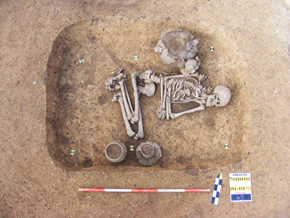A team of researchers from the Czech Archaeological Society excavated a skeleton of a prehistoric man who they believe to be a homosexual or transsexual who lived between 4.500 and 5.000 years ago.
Taken from a Neolithic archaeological site in Prague, the fossil remains indicate that the male individual was buried according to rites normally intended for women.
"We work with two hypotheses. That the individual could have been a shaman or someone of the third sex. As the set of objects found buried around the skeleton did not corroborate the hypothesis that he was a shaman, it is more likely that the second explanation is the correct one", said archaeologist Katerina Semradova to "BBC Brasil".
According to the archaeologist, men are normally buried on their right side, with their heads facing west, along with tools, weapons, food and drinks. Women are normally on their left side, facing east and surrounded by jewelry and household objects.
"From historical and ethnological knowledge, we know that people in this period took funeral rituals very seriously, so it is unlikely that this position was a mistake," said research coordinator Kamila Remisova Vesinova. "It's more likely that he had a different sexual orientation," she said.



